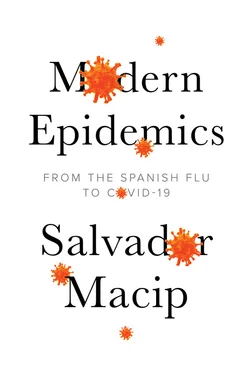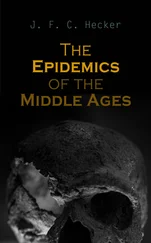There are more than a million kinds of microorganisms, most of them inoffensive. The main ones are bacteria and viruses, but to these must be added certain fungi, algae and amoebas. In both number and weight, microorganisms are predominant among living beings. If we could put all the microbes on one side of the scale and all the animals on the other, the microbes would weigh twenty-five times more. The fastest growing microbes duplicate every thirteen minutes, and the slowest every fourteen days. At this rate, if a single bacterium had all the possible nutrients and the right conditions, it could generate a colony that would weigh as much as the whole Earth in three days.
We shouldn’t forget that it’s thanks to microbes that this planet is habitable. Some 2,700 million years ago, there appeared a certain kind of bacterium that was able to use sunlight to transform water and CO 2into energy. A secondary effect of this process, which is called photosynthesis , is generation of oxygen. Like toxic exhaust fumes given off by a car engine, the oxygen kept accumulating in huge quantities and ‘contaminating’ the Earth’s atmosphere. This inadvertent pollution ended up being providential for us as it permitted the appearance of a new class of beings – humans among them – that needed oxygen for their basic functions. To this very day, bacteria are important for keeping the planet in balance. Without them, life on Earth would be wiped out.
Bacteria could also survive in outer space. Some very tiny species have been found (among them Herminiimonas glaciei , which was discovered in 2009). They can endure for more than 120,000 years under layers of ice three kilometres thick, practically without oxygen and nutrients. These conditions are very similar to those that might be found outside our planet.
We should be grateful for other things, too. Bacteria are also our ancestors. As I said, life on Earth was at first limited to minuscule single cell organisms. They gradually began to come together in groups of cells that, acting in concert, went on to specialize in different functions, now in the form of what are known as multicellular organisms. This is the path that led to the fabulous biological diversity we have today. As proof of our humble origins, there are still structures in human cells that come directly from those original bacteria. And they are essential for human life.
We shouldn’t necessarily see microorganisms as a threat. On the contrary, coexistence with many of them is highly beneficial for humans and determines proper functioning of the organism. The human body, one of the most complex multicellular organisms in existence, consists of approximately 100 billion cells. But this needs to be clarified: I mean 100 billion human cells. If we are to be exact, we also need to count all the microorganisms that inhabit us. Initially, it was calculated that they might be ten times more numerous than our own cells, but more recent data suggest that a closer estimate would be one microbe for each human cell. In any case, we can venture that the human body is colonized by millions of microorganisms, of some 400 different species, which normally don’t cause any illness. Put together they would weigh a kilogram. These data are mind-boggling, enough to make us wonder what a human being really is. A mixture of highly specialized cells and microbes that live in harmony? From this standpoint, we are perhaps nothing more than a walking ecosystem in which a series of microorganisms peaceably survive.
The microbes that are always with us are not only freeloaders but ‘stowaways’ that are very important for our metabolism. Humans, like all other animals, depend on them to survive. From them, we obtain vitamins, nutrients and protection against infections caused by their more toxic kin. Cows, for example, couldn’t ingest grass without the help of the bacteria they have in their digestive tract, and neither could termites benefit from the cellulose in wood. There are plants we use as food, peas and beans for example, that need bacteria in order to fix the essential nitrogen from the sun.
Further proof of their importance is that it is thought that, when giving birth, mothers pass on to their children the ‘good’ bacteria that will settle in their digestive systems and protect them in the future. Hence, there are studies exploring what happens to babies born by caesarean, because these children haven’t had to pass through the vaginal canal that would equip them with their first microorganisms. It’s not yet sure what effect this might have on their future health.
By convention, microorganisms, like all other living beings, are designated by using a first name (with the first letter capitalized) and a second name, both in Latin. The first is the genus name and the second the species name. The genus name can be abbreviated to the initial alone, and both tend to be italicized. Example: Mycobacterium tuberculosis (or M. tuberculosis ) is a species of bacteria of the genus of microbacteria that causes tuberculosis.
In the domain of health, more and more importance is being given to what’s known as the microbiota , or the set of all the microorganisms each person carries inside (and on the surface). It’s believed that, depending on which microbes inhabit this microbiota, we can be more or less prone to certain illnesses or conditions.
One example of this would be that the type of bacteria found in intestines could determine whether we gain weight or not, as was first suggested in a study from 2006. After isolating intestinal bacteria from mice of normal weight and from others that were obese, scientists found that bacteria from the latter contributed towards weight gain in the former, even when they continued with the same diet. Humans have between 500 and 1,000 different species of bacteria in the digestive tract and it might well be that these also have an influence on a person’s susceptibility to gaining weight. More recent studies support this theory. For example, in 2009 it was found that obese women have a high presence in their saliva of bacteria called Selenomonas noxia . By contrast, thin women show a very different set of bacteria.
It’s been known for some time now that antibiotics can disrupt the balance of ‘good’ bacteria. Medicines eliminate infections but are unable to distinguish between aggressive and innocuous microbes. Depending on the treatment, even weeks can go by in some cases before the bacterial composition of the intestine, for example, completely recovers. This can then give rise to diarrhoea or new infections caused by other harmful bacteria, especially in people already weakened by illness.
This shows that it is not only our intestines that are full of microorganisms. Our mouths, too, normally have between six and thirty different types of bacteria. And skin is another organ that is home to thousands more. It was once believed that most of them were of the genus Staphylococcus , because when samples taken from human skin were cultivated in the laboratory, they were the most visible. But this doesn’t mean that there aren’t many more. There are others that don’t divide so quickly. Indeed, with the new tools of genetic analysis, it’s been possible to see that the set of denizens of human skin is much more complex than was previously thought, with up to 1,000 different species, which is to say, a number that’s comparable with that for the intestines. The skin behind the ear is the zone with the least diversity of bacteria, with only fifteen kinds, while the forearm has as many as forty-four. This varying distribution might explain whysome skin diseases appear in certain zones and not in others. As in the intestines, bacteria on the skin have important functions, so, for example, oilier zones have some bacteria that produce a moisturizing substance to stop the skin from cracking.
Читать дальше












